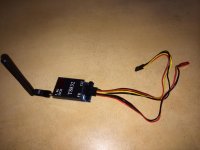gomotomoto
Member
Ok, so brand new to FPV. Have no idea what i'm doing with FPV. Just finished a successful 450 build (thanks bart) and trying the next challenge.
This is going on my 550 (transmitting video signal back to a monitor with a built in receiver)
Question, do I solder the positive and negative directly to a + - on my lower board, or will that fry this thing? There's no info on the box as far as voltage it needs and don't want to assume there's a built in voltage regulator.
I bought these items from Aerial Media Pros:
http://aerialmediapros.com/store/na...a-m-v2-wgps-combo-with-iosd-mini-and-btu.html
http://aerialmediapros.com/store/fpv-items/404-32-ch-58-ghz-digital-tx-600mw.html
http://aerialmediapros.com/store/fpv-items/384-7-monitor-w-built-in-diversity-receiver.html
Instructions are pretty weak, even on the DJI site. Can anyone point me in the right direction as far an an install?
Thanks
View attachment 16916
This is going on my 550 (transmitting video signal back to a monitor with a built in receiver)
Question, do I solder the positive and negative directly to a + - on my lower board, or will that fry this thing? There's no info on the box as far as voltage it needs and don't want to assume there's a built in voltage regulator.
I bought these items from Aerial Media Pros:
http://aerialmediapros.com/store/na...a-m-v2-wgps-combo-with-iosd-mini-and-btu.html
http://aerialmediapros.com/store/fpv-items/404-32-ch-58-ghz-digital-tx-600mw.html
http://aerialmediapros.com/store/fpv-items/384-7-monitor-w-built-in-diversity-receiver.html
Instructions are pretty weak, even on the DJI site. Can anyone point me in the right direction as far an an install?
Thanks
View attachment 16916
Attachments
Last edited by a moderator:

